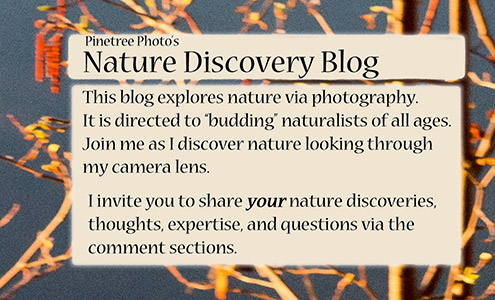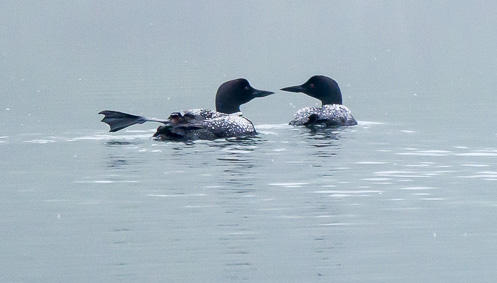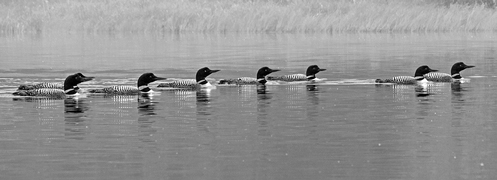Posted in Uncategorized
Tags: budding naturalist, hiking, loons, nature blog, nature photography, northern Minnesota, wildflower
Fall Tamarack Time: The Golden Days
•October 14, 2014 • 6 CommentsThe golden days of the tamaracks are upon us, and a sunny day brings out their best. The tamarack is the only conifer tree that changes color and drops its needles in the fall. The tamarack is found in the bogs, swamps, and other lowland areas of northern Minnesota. A warm and sunny fall day inspired a drive and a hike on Lake Bemidji State Park’s Bog Walk to check them out. On the way there, I had to remind myself to keep my eyes on the road.
While the wildflowers are gone, the bog walk is still beautiful this time of year.
I caught a glimpse of a tamarack bathed in sunlight in a small clearing. It appeared to glow.
The view of Big Bog Lake at the end of the boardwalk was spectacular.
Pretty as it was today, soon the needles will drop and leave the branches bare. However, come spring, the cycle starts all over again with a fresh batch of green.
Rydell National Wildlife Refuge Fall Hike
•September 27, 2014 • 4 CommentsI recently made a stop at the Rydell National Wildlife Refuge (located in northwestern MN just off Hwy 2-about halfway between Bemidji, MN and Grand Forks, N.D.) Woodlands, tall grass prairie, and bogs provide habitat for a wide variety of plants and animals. Birds and waterfowl enjoy the lakes and ponds within the refuge. Seven miles of trails provide great hiking and the opportunity for wildlife observation and photography.
We chose to hike the 1.5 mile Golden Pond Trail. This trail starts at the visitor center, wanders around Golden Pond and then takes you into hardwood forrest and through restored prairie. The visitor center has a large viewing deck overlooking Golden Pond (full of ducks and a family of trumpeter swans) with Sunset Lake in the background, as seen in the above photo. Below is a photo of the viewing deck shot from the other side of the pond.
As the trail leaves Golden Pond you begin to wander under a canopy of hardwoods.
“This place is getting rather seedy.” I didn’t expect to see a lot of wildflowers blooming at this time of year, but did find a few. I also got an interesting view into the life cycle of plants, and how they assure that they are going to be back next year. Regrettably, several of the species below are non-native plants considered invasive (Queen Anne’s Lace, Bull Thistle, Chicory) and tend to take over an area once established. While pretty, they are not desirable to have around.
For more information on this wonderful gem, please check out their website Rydell National Wildlife Refuge.
Loon Foot Waggle at the Loon Gathering
•August 6, 2014 • 9 CommentsWhile kayaking one recent early morning in the foggy mist, I observed two curious loon behaviors, the gathering of a number of loons and the loon foot waggle . The gathering of loons I am referring to occurs when a number (nine in this case) of loons gather together on a lake, and one is sure that not all of those loons typically inhabit the lake. A loon foot waggle occurs when a loon sticks one of their feet up out of the water and wiggles it. I have observed both of these behaviors on a number of occasions and wondered, “Why do they do that?” I did a bit of research on both behaviors, and found that while there are various thoughts on the “why” of these behaviors, there is still a bit of mystery as well.
In fact one of the resources I found was called, The Mystery of the Loon Breakfast Club, an article by Brian M. Collins in Cabin Life magazine. The scenario that he described is similar to what I observed. The loons gathered in a group; splashing, diving, occasionally two would appear to touch their beaks together, and now and then the curious foot waggle was displayed. Loons joined the group by doing a fly-over, then splashing down in the water a short ways from the group, and swimming over to join the rest.
When the group moved they moved en masse, either bunched together or sometimes in a row. Possible reasons why loons gather for this period of social interaction include: they are preparing for fall migration, it is a time for play and learning, or it could be a prelude to next year’s mating season. I noted two loons turn toward each other and appear to touch beaks, could that be part of a mating ritual?
What about that foot waggle? Possible reasons put forth for this behavior include: it’s a means of stretching to help the loon feel more comfortable, it’s associated with preening and resting behavior, it’s a way for the loon to regulate body temperature, and/or it may aid in circulation. That it is a feel-good stretching behavior makes a lot of sense to me. (A helpful resource for information on loon behavior is the LoonWatch website.)
Northland Arboretum Wildflowers and a Rose
•July 18, 2014 • 11 CommentsSome people have lifetime birding lists. I have a lifetime wildflower list. (Wildflowers are better at sitting still, so I can identify them.) I found myself in Brainerd, Minnesota this week at a reunion of old college friends and slipped away for a couple of hours in the afternoon with a friend to hike trails at the Northland Arboretum. The Northland Arboretum is a beautiful nature area with year-round trails. It offers both trail views of wildflowers as well as groomed gardens containing many other beautiful flowers.
The prize of the day came early in our hike. A short ways down the “Little Ben” trail, we noticed several bright orange wood lilies. To our delight a Monarch butterfly was perched on one, sucking up nectar. These days I take special notice when I see a Monarch butterfly – it is becoming a rather rare experience. The population of Monarchs is declining due to a loss of habitat. We saw only three Monarchs on our hike – would have expected more considering the excellent habitat for Monarchs at the Northland Arboretum. (For more information on the declining Monarch population and what you can do, check out the MonarchWatch.org website.)
Other wildflowers observed along the trails (“”Little Ben”, “Big Ben”, or the “Johnson Plantation”) we walked included the Spiderwort (a native with a gorgeous blue/purple color set off by the yellow pollen sacks), the Butterfly-Weed (a butterfly magnet because of its bright color and the amount of nectar it produces), the Hoary Puccoon (I have observed this flower in a light orange many times, but these were definitely yellow -it is a native plant that was used as a source of dye at one time.), and the Dame’s Rocket (According to the Eloise Butler website, it originated in Italy, was a favorite of Marie Antoinette, and is now considered an invasive plant.)
At the end of our hike we took a minute to rest up in the gazebo and take a look at the garden flowers. I couldn’t help but notice this lovely rose.
Kadunce River Hiking Trail
•June 9, 2014 • 5 CommentsAbout 10 miles north of Grand Marais the Kadunce River flows into Lake Superior. The Kadunce River Hiking Trail runs through the woods next to the river and ties into the Superior Hiking Trail. On June 6th I hiked the .9 mile trail to the Kadunce Bridge on the lookout for spring wildflowers. I was not disappointed.
A perfect donut of foam was formed by the swirling water. The river rock is reddish giving the water an orange hue.
Bunchberries were out in force all along the trail.
Not only bunchberries, but many blueberries were next to the trail as well. Wish I could be here when they ripen.
While the trail initially runs next to the river, it soon leaves the water’s edge as it climbs the hill beside the river, and the river runs in the gorge below.
I found two more of my favorite spring flowers as well, the starflower and clintonia or blue-bead lily.
The prize of the trip was a beautiful pink flower next to the bridge. It was not one that I recognized nor could I find it in any of my guidebooks. So, I got some help from Sparky (The PhotoNaturalist) and found out it is purple clematis. I have clematis vines in my garden, but didn’t realize there was a wild version. I now see the vines of the plant – a definite clue in the identification.
I love this time of year in the northwoods!
Sundew Pond at Lake Bemidji State Park
•August 29, 2013 • 5 CommentsHints of fall are seen in nature’s colors on the Sundew Pond. I took a walk just before sunset and couldn’t help but anticipate what I would see as I headed down boardwalk toward the floating overlook.
It was perfect timing for the perfect spot. The golden light of the sunset emphasized the emerging golds in the tamarack and grasses surrounding the pond.
Brightly colored flowers are becoming harder to find, but berries, mushrooms and frogs still abound on the Fish Hawk Trail that leads to and from the Sundew Pond.
By the time I returned to the boat landing area where I left the car, the final colors of a beautiful sunset over Lake Bemidji glowed across the lake.










































